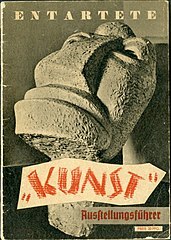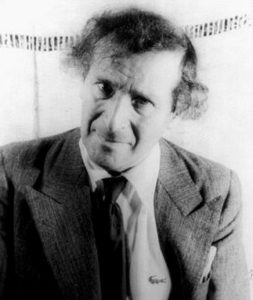It takes planning and a little willpower to visit Marc Chagall’s painting “Purim” during the pandemic.
You have to reserve a time slot at the Philadelphia Museum of Art in advance, get your temperature taken when you get there, and navigate the museum’s warrens of galleries. But it was a similarly circuitous route — from pre-revolutionary Russia to Nazi Germany, from Brooklyn to Philadelphia — that brought “Purim” to Gallery 267a.
Chagall was in high demand when he painted “Purim” in 1916. Back in his hometown of Vitebsk in present-day Belarus after nearly a decade in St. Petersburg and Paris, Chagall was fresh off of successful exhibitions in Berlin and Moscow and snared a commission from the Petrograd Jewish Society for the Promotion of the Arts.
The society tasked him with creating large-scale murals of religious festivals for a Jewish secondary school attached to the city’s main synagogue. “Purim,” a study Chagall painted in preparation, depicts a man and a woman as they prepare to exchange gifts for the holiday; the word “Purim” is written in Hebrew in the corner of the study.

“He had gotten connected with these artists who were really very interested in exploring Jewish visual traditions, among others, in order to create a kind of authentically Jewish modern art in Russia,” said Matthew Affron, the Muriel and Philip Berman Curator of Modern Art at the museum.
The era of “Purim” was a fruitful one for Chagall; the following year, the revolutionary Soviet government asked him to serve as commissar for the arts, but Chagall declined, establishing a school in Vitebsk instead.
The commissioned murals were never completed, but Chagall took “Purim” with him when he moved to France a few years later, and sold it to Dr. Herbert Tannenbaum, a German-Jewish art dealer. Tannenbaum lent “Purim” to a Chagall exhibition in Cologne in 1925, and in 1928, sold it to a museum in Essen, Germany. But as Chagall’s star rose higher in Europe, so too did other forces.
A day after Chagall’s 50th birthday in 1937, “Purim” was confiscated by Nazi authorities for The Degenerate Art Exhibition, conceived by Joseph Goebbels, Affron said. The exhibit in Munich, intended to denigrate the work on display, featured more than 5,000 confiscated paintings and sculptures deemed insufficiently patriotic, exceedingly modern in style or generally inimical to the
Aryan ideal.
Several paintings from Chagall were displayed in a room designated for the disparagement of Jewish art, Affron said. More than 2 million people attended the exhibition as it traveled around Germany.
In 1941, Chagall and his wife just barely escaped Vichy France for the U.S. without “Purim,” which had been given to Ferdinand Möller, an art dealer appointed by the Nazis to sell “degenerate art” on the international market. According to the PMA, Möller failed, as the painting was sold to a German, Dr. Kurt Feldhäusser, who was killed in an Allied bombing raid. His mother brought “Purim” to Brooklyn in 1948; the following year, it was sold to lawyer Louis E. Stern.
Stern, born in Balta, Russia, in 1886, was raised in Vineland, New Jersey, and went to law school at the University of Pennsylvania. He practiced international law in Atlantic City, Newark, New Jersey, and New York, and amassed a considerable art collection, including many works by Chagall, who became a personal friend.

Carl Van Vetchen/Library of Congress/Wikimedia Commons
When Stern died in 1962, some of his art collection went to the Brooklyn Museum and the Museum of Modern Art, while his art library went to Rutgers University. But the bulk of the collection, including “Purim,” was left to the PMA, where it hangs today in Gallery 267a.
[email protected]; 215-832-0740



